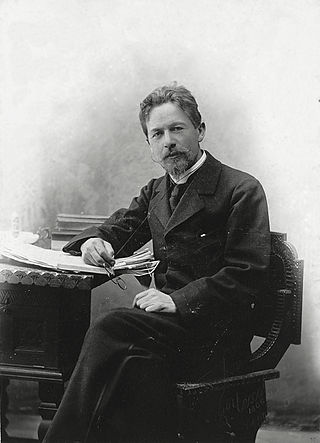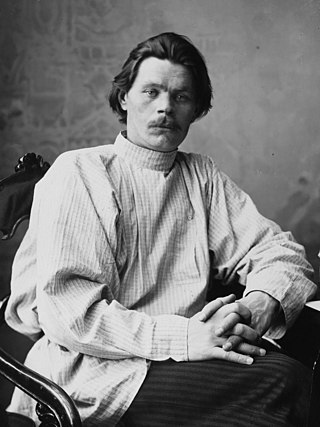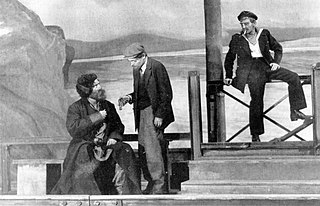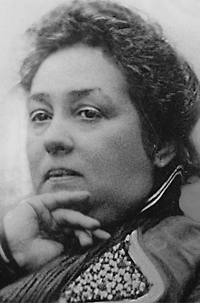
Anton Pavlovich Chekhov was a Russian playwright and short-story writer who is considered to be one of the greatest writers of all time. His career as a playwright produced four classics, and his best short stories are held in high esteem by writers and critics. Along with Henrik Ibsen and August Strindberg, Chekhov is often referred to as one of the three seminal figures in the birth of early modernism in the theatre. Chekhov was a physician by profession. "Medicine is my lawful wife", he once said, "and literature is my mistress."

Konstantin Sergeyevich Stanislavski was a seminal Soviet Russian theatre practitioner. He was widely recognized as an outstanding character actor, and the many productions that he directed garnered him a reputation as one of the leading theatre directors of his generation. His principal fame and influence, however, rests on his "system" of actor training, preparation, and rehearsal technique.

Method acting, known as The Method, is a range of rehearsal techniques, as formulated by a number of different theatre practitioners, that seeks to encourage sincere and expressive performances through identifying with, understanding, and experiencing a character's inner motivation and emotions. These techniques are built on Stanislavski's system, developed by the Russian actor and director Konstantin Stanislavski and captured in his books An Actor Prepares, Building a Character, and Creating a Role.

Alexei Maximovich Peshkov, popularly known as Maxim Gorky, was a Russian and Soviet writer and socialist political thinker and proponent. He was nominated five times for the Nobel Prize in Literature. Before his success as an author, he travelled widely across the Russian Empire changing jobs frequently, experiences which would later influence his writing.

The Seagull is a play by Russian dramatist Anton Chekhov, written in 1895 and first produced in 1896. The Seagull is generally considered to be the first of his four major plays. It dramatizes the romantic and artistic conflicts between four characters: the famous middlebrow story writer Boris Trigorin, the ingenue Nina, the fading actress Irina Arkadina, and her son the symbolist playwright Konstantin Treplev.

The Power of Darkness is a five-act drama by Leo Tolstoy. Written in 1886, the play's production was forbidden in Russia until 1902, mainly through the influence of Konstantin Pobedonostsev. In spite of the ban, the play was unofficially produced and read numerous times.

Stanislavski's system is a systematic approach to training actors that the Russian theatre practitioner Konstantin Stanislavski developed in the first half of the twentieth century. His system cultivates what he calls the "art of experiencing". It mobilises the actor's conscious thought and will in order to activate other, less-controllable psychological processes—such as emotional experience and subconscious behaviour—sympathetically and indirectly. In rehearsal, the actor searches for inner motives to justify action and the definition of what the character seeks to achieve at any given moment.

The Moscow Art Theatre (or MAT; Russian: Московский Художественный академический театр, Moskovskiy Hudojestvenny Akademicheskiy Teatr was a theatre company in Moscow. It was founded in 1898 by the seminal Russian theatre practitioner Konstantin Stanislavski, together with the playwright and director Vladimir Nemirovich-Danchenko. It was conceived as a venue for naturalistic theatre, in contrast to the melodramas that were Russia's dominant form of theatre at the time. The theatre, the first to regularly put on shows implementing Stanislavski's system, proved hugely influential in the acting world and in the development of modern American theatre and drama.
Twentieth-century theatre describes a period of great change within the theatrical culture of the 20th century, mainly in Europe and North America. There was a widespread challenge to long-established rules surrounding theatrical representation; resulting in the development of many new forms of theatre, including modernism, expressionism, impressionism, political theatre and other forms of Experimental theatre, as well as the continuing development of already established theatrical forms like naturalism and realism.
Literary realism is a literary genre, part of the broader realism in arts, that attempts to represent subject-matter truthfully, avoiding speculative fiction and supernatural elements. It originated with the realist art movement that began with mid-nineteenth-century French literature (Stendhal) and Russian literature. Literary realism attempts to represent familiar things as they are. Realist authors chose to depict every day and banal activities and experiences.
My Life in Art is the autobiography of the Russian actor and theatre director Konstantin Stanislavski. It was first commissioned while Stanislavski was in the United States on tour with the Moscow Art Theatre, and was first published in Boston, Massachusetts in English in 1924. It was later revised and published in a Russian-language edition in Moscow under the title Моя жизнь в искусстве. It is divided into 4 sections entitled: 1-Artistic Childhood, 2-Artistic Youth, 3-Artistic Adolescence and 4-Artistic Adulthood.

The Moscow Art Theatre production of Hamlet was a 1911–12 production of Hamlet, produced by Konstantin Stanislavski and Edward Gordon Craig. It is particularly important in the history of performances of Hamlet and of 20th-century theatre in general. Despite hostile reviews from the Russian press, the production attracted enthusiastic and unprecedented worldwide attention for the theatre, with reviews in Britain's The Times and in the French press that praised its unqualified success. The production placed the Moscow Art Theatre "on the cultural map for Western Europe", and it came to be regarded as a seminal event that influenced the subsequent history of production style in the theatre and revolutionised the staging of Shakespeare's plays in the 20th century. It became "one of the most famous and passionately discussed productions in the history of the modern stage."

The Moscow Art Theatre production of The Seagull in 1898, directed by Konstantin Stanislavski and Vladimir Nemirovich-Danchenko, was a crucial milestone for the fledgling theatre company that has been described as "one of the greatest events in the history of Russian theatre and one of the greatest new developments in the history of world drama." It was the first production in Moscow of Anton Chekhov's 1896 play The Seagull, though it had been performed with only moderate success in St. Petersburg two years earlier. Nemirovich, who was a friend of Chekhov's, overcame the writer's refusal to allow the play to appear in Moscow after its earlier lacklustre reception and convinced Stanislavski to direct the play for their innovative and newly founded Moscow Art Theatre (MAT). The production opened on 29 December [O.S. 17 December] 1898. The MAT's success was due to the fidelity of its delicate representation of everyday life, its intimate, ensemble playing, and the resonance of its mood of despondent uncertainty with the psychological disposition of the Russian intelligentsia of the time. To commemorate this historic production, which gave the MAT its sense of identity, the company to this day bears the seagull as its emblem.

Naturalism is a movement in European drama and theatre that developed in the late 19th and early 20th centuries. It refers to theatre that attempts to create an illusion of reality through a range of dramatic and theatrical strategies. Interest in naturalism especially flourished with the French playwrights of the time, but the most successful example is Strindberg's play Miss Julie, which was written with the intention to abide by both his own particular version of naturalism, and also the version described by the French novelist and literary theoretician, Emile Zola.
Ioasaf Aleksandrovich Tikhomirov (1872-1908) was a male actor from the Russian Empire. He trained under Vladimir Nemirovich-Danchenko, who offered "rigorous and intelligent" courses in actor training at the school of the Moscow Philharmonic Society. Tikhomirov was one of twelve students that Nemirovich brought with him to join the Moscow Art Theatre when he founded it with Constantin Stanislavski in 1898. He acted with the company until 1904 and also served as the director of the Art Theatre School. In 1904 Stanislavski sent Tikhomirov to help Maxim Gorky establish his newly founded theatre in Nizhny Novgorod, but the project was abandoned when the Russian censor banned every play that they proposed to stage.

Armoured Train 14–69 is a 1927 Soviet play by Vsevolod Ivanov. Based on his 1922 novel of the same name, it was the first play that he wrote and remains his most important. In creating his adaptation, Ivanov transformed the passive protagonist of his novel into an active exponent of proletarian ideals; the play charts his journey from political indifference to Bolshevik heroism. Set in Eastern Siberia during the Civil War, it dramatises the capture of ammunition from a counter-revolutionary armoured train by a group of partisans led by a peasant farmer, Nikolai Vershinin. It is a four-act play in eight scenes that features almost 50 characters; crowd scenes form a prominent part of its episodic dramatic structure. Near the end of the play a Chinese revolutionary, Hsing Ping-wu, lies down on the railway tracks to force the armoured train to stop.
The Ascension of Little Hannele, also known simply as Hannele, is an 1893 play by the German playwright Gerhart Hauptmann. In contrast to Hauptmann's naturalistic dramas, The Assumption of Hannele adopts a more symbolist dramaturgy and includes a dream sequence. The play is the first in recorded world literature with a child as its heroine. The play tells the story of a neglected and abused peasant child, who, on her deathbed, experiences a vision of divine powers welcoming her into the afterlife. It was first published in 1894. Hauptmann was awarded the Grillparzer Prize in 1896 for the play.

Vasily Ivanovich Kachalov, was one of Russia's most renowned actors. He worked closely and often with Konstantin Stanislavski. He led the so-called Kachalov Group within the Moscow Art Theatre. It was Kachalov who played Hamlet in the Symbolist production of 1911.

Maria Alexandrovna Samarova was a Moscow-born Russian Empire and Soviet stage actress and reader in drama, associated with the Moscow Art Theatre.














